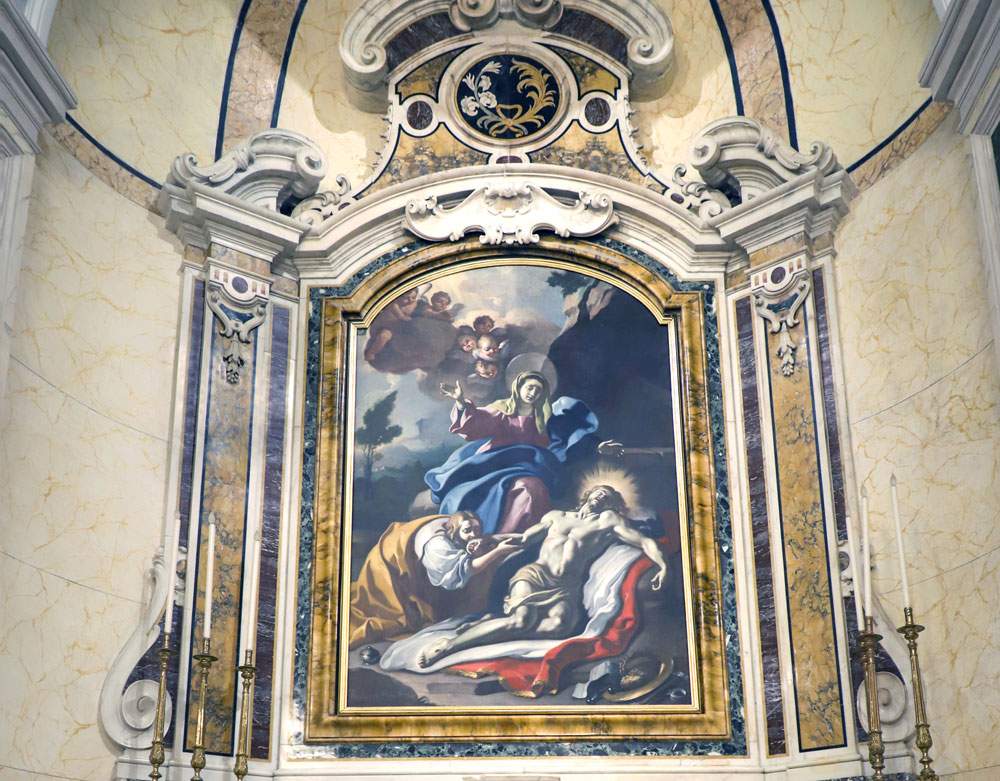Foggia Cathedral's Pieta restored
The marvelous Pietà ofclassical-baroque layout by Paolo De Maio, made in 1741, is back after restoration in Foggia Cathedral.
The work was carried out by restorer Daniela Pirro, under the high supervision of the Soprintendenza Archeologia Belle Arti e Paesaggio for the provinces of Barletta-Andria-Trani and Foggia, and under the coordination of Antonio Ricci, Office for Ecclesiastical Cultural Heritage - Archdiocese Foggia-Bovino of the Archdiocese of Foggia. The restoration was fully funded by Opera Tua of Coop Alleanza 3.0, with Fondaco Italia, the Association of Italian UNESCO Heritage Sites and the Italian Touring Club.
The painting, a large oil on canvas, is signed and dated and follows the iconographic scheme of the mourning of the Madonna over the dead Christ. Christ, in the center, is lifeless and silhouetted against the draperies of fabrics on which the body falls. He is mourned by his mother and the apostle John, as per typical iconography. Above, clouds rise that house five curly putto heads and two little angels, composing a baroque pattern. In the background is a bare landscape. The I.N.R.I cartouche, crown of thorns, and instruments of crucifixion are visible in the lower right.
Christ’s body is lying on the stone, one arm falls back and the rest of the body rests on a white sheet. Both this and the loincloth, symbols of his mission of purification, form rich folds that create a draping movement. John kisses a hand of Christ venerating him. The rendering of the whole is very realistic and scenic, typical of the author’s Baroque style, with particular care and richness even in the details: the rocks with the vegetation, the cherubs and angels, the tree with fronds in the wind, the village along the line of the horizon plane, the draperies of the fabrics. The Virgin replaces the cross, becoming both a symbol of the crucifixion and a crucified mother herself.
The primary colors are used with symbolic appeal: the blue of the Virgin’s mantle recalls transcendence and divine ineffability, the yellow of John’s garment becomes a symbol of the soul’s union with God, the red of the cloth on which placed Christ refers to the sacrifice, but also to the purifying value of fire, to the love of the revealed Word; finally, the white of the sacred linen implicitly cites the Gospel passage “I am the light of the world, he who follows me does not walk in darkness, but will have the light of life” (Jn. 8:12).
Its author, Paolo De Maio (Marcianise, 1703 - Naples, 1784), was among the most frequent visitors to the workshop of Baroque painter Francesco Solimena. From the latter he took up the refined balance of forms through chiaroscuro and maturity in the representation of bodies, modeled on classical statuary. Between the 1830s and 1840s the artist was influenced by the Arcadian style of Francesco de Mura and Jesuit doctrine. Paintings from the 1940s such as the Pieta in Foggia Cathedral show the artist’s willingness to reconcile the purism of Arcadian classicism with almost catechetical didactic aims, achieving very high pictorial results.
The work was restored because it was in a state of deterioration following interventions in the second quarter of the 20th century. Due to a major loss of original paint film in the upper part of the painting, it was subjected to a lining operation with three canvases sewn together and a cursory operation of cleaning the paint film, as well as plastering and a major patination of the entire area of the cliff located behind the Virgin and Christ. Eighty-seven perimeter nails had been nailed along the entire front of the painting, damaging the pictorial film and causing the detachment of several pictorial layers. The entire textile support was damaged by tears, sagging, and microbiological attack.
After preliminary investigations by UV fluorescence and digital microscope, cleaning, consolidation, suturing, lining, construction of a new wooden frame, plastic reintegration of the gaps, and construction of a new frame were then carried out.
Pictured is the Pietà relocated at the end of restoration in Foggia Cathedral.
 |
| Foggia Cathedral's Pieta restored |
Warning: the translation into English of the original Italian article was created using automatic tools. We undertake to review all articles, but we do not guarantee the total absence of inaccuracies in the translation due to the program. You can find the original by clicking on the ITA button. If you find any mistake,please contact us.




























